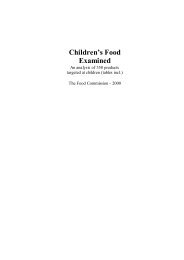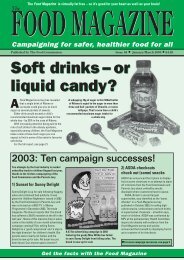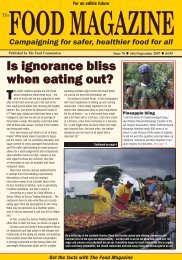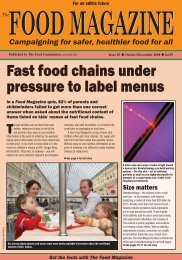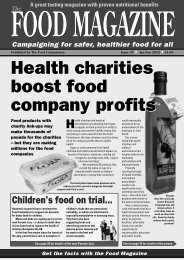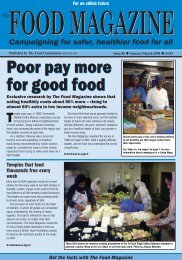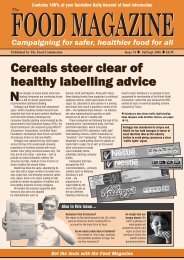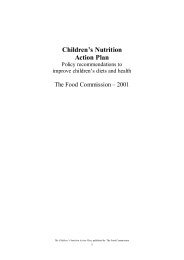Campaigning for safer, healthier food for all - The Food Commission
Campaigning for safer, healthier food for all - The Food Commission
Campaigning for safer, healthier food for all - The Food Commission
Create successful ePaper yourself
Turn your PDF publications into a flip-book with our unique Google optimized e-Paper software.
feedback<br />
letters from our readers<br />
We welcome<br />
letters from <strong>all</strong> of<br />
our readers but<br />
we do sometimes<br />
have to shorten them so that we can include as many<br />
as possible (our apologies to the authors). You can<br />
write to <strong>The</strong> Editor, <strong>The</strong> <strong>Food</strong> Magazine, 94 White Lion<br />
Street, London N1 9PF or email to<br />
letters@<strong>food</strong>comm.org.uk<br />
Free seed?<br />
Many thanks <strong>for</strong> the latest <strong>Food</strong> Magazine. A<br />
very good read; congratulations. If I may offer a<br />
comment on the Terminator story published in<br />
FM72 – saved seed is not free. <strong>The</strong> farmer<br />
carries the costs of growing it, harvesting and<br />
storing it. <strong>The</strong> first two incur direct costs, and<br />
the third an opportunity cost (the potential<br />
income from selling the seed). <strong>The</strong>se may well<br />
be cheaper than buying Terminator seed, but<br />
saved seed is certainly not free.<br />
Ian Grant, by email<br />
Corrections<br />
Our article ‘Nutrition, mental health and<br />
behaviour’ in FM72 should have been credited to<br />
Courtney Van de Weyer (not Weyner). In the<br />
same article we neglected to credit the<br />
photographer TS Whalen <strong>for</strong> both of the images<br />
we used, <strong>for</strong> which apologies.<br />
Marks & Spencer gets its<br />
GDAs in a twist<br />
Reader Bridget Henderson alerted us to confused<br />
labelling on Marks & Spencer yogurts. Why, she<br />
wondered, did one product recommend a daily<br />
intake of 1,400 calories <strong>for</strong> women and 2,000<br />
calories <strong>for</strong> men, when another recommended a<br />
higher daily intake of 2,000 calories <strong>for</strong> women<br />
and 2,500 calories <strong>for</strong> men? She sent us a label<br />
that clearly showed this confused advice,<br />
including the reassuring statement that these<br />
daily amounts were ‘recommended by nutrition<br />
professionals <strong>for</strong> average adults’.<br />
We investigated and found that M&S do<br />
indeed suggest two different Guideline Daily<br />
Amounts (GDAs). One is <strong>for</strong> everyday use and<br />
the other is described as ‘Guideline Daily<br />
Amounts <strong>for</strong> Sustainable Weight Loss’.<br />
GDA labelling is already confusing enough<br />
without supermarkets introducing different GDAs<br />
<strong>for</strong> different sectors of the market. And what<br />
exactly is ‘sustainable weight loss’? Does this<br />
mean that slimmers who eat M&S products can<br />
sustain continual weight loss <strong>for</strong>ever? That<br />
sounds like a one-way ticket to us!<br />
Why don’t Shredded<br />
Wheat GDA sums add up?<br />
You may be<br />
interested to see the<br />
enclosed side panel<br />
from a box of<br />
Shredded Wheat.<br />
You will see it<br />
claims that a 45g<br />
serving with 125ml<br />
of semi-skimmed<br />
milk provides,<br />
among other things,<br />
48g of Whole Grain.<br />
Presumably at least<br />
3g of that has to<br />
come from the milk?<br />
Roger Griffin, Cambridge<br />
We’ve seen the humble pinta enriched with<br />
omega-3 oils, plant sterols and even higher<br />
levels of melatonin (supposedly to aid sleep),<br />
but wholegrain milk is a new one to us!<br />
However, further investigation reveals that<br />
this apparent anomaly is actu<strong>all</strong>y due to UK<br />
labelling legislation which requires ingredient<br />
quantities to be declared as ‘put into the mixing<br />
bowl’. We understand that it takes 48g of wheat<br />
to make 45g of Shredded Wheat, as processing<br />
removes roughly 3g of moisture. Hence the<br />
curious figure of 48g.<br />
Nestlé admits that some ingredients are ‘nasties’<br />
I was delighted to see that Nestlé seems to think<br />
artificial colours, sweeteners and preservatives<br />
are ‘nasties’ in this advert <strong>for</strong> Ski yogurt. It’s a<br />
pity that the company doesn’t recognise the<br />
unidentified, and presumably artificial ‘flavouring’<br />
present in its Ski yogurts as a ‘nasty’ as well:<br />
especi<strong>all</strong>y since, with the addition of a bit more<br />
good quality fruit, doctoring them with<br />
‘flavouring’ wouldn’t be necessary. <strong>The</strong>n Nestlé’s<br />
yogurts re<strong>all</strong>y would be ‘simple’.<br />
Joanna Clarke, Glasgow<br />
It seems Nestlé has no objection to adding<br />
what it admits to be ‘nasties’ to many of its<br />
other products. A snap survey found the<br />
following Nestlé products <strong>all</strong> contain artificial<br />
colourings, sweeteners or preservatives:<br />
Sveltesse Yogurt Smoothies (sweeteners<br />
aspartame and acesulfame-K);<br />
Sveltesse Real Fruit Yogurts (sweeteners<br />
aspartame and acesulfame-K and the<br />
preservative potassium sorbate);<br />
Aero Minty Bubbles (colouring brilliant blue<br />
FCF, which comes from the controversial<br />
range of azo dyes);<br />
‘Egg Splat’ Fromage Frais Dessert<br />
(preservative potassium sorbate);<br />
Nesquik Magic Straws (sweetener<br />
aspartame-acesulfame);<br />
Coffee Mate Virtu<strong>all</strong>y Fat Free (colouring<br />
E171 – see ‘sunblock’ story on page 24);<br />
Vittel Flavoured Waters (sweeteners<br />
acesulfame-K and Sucralose);<br />
Rowntree (a Nestlé subsidiary) Fruit Pastille<br />
lollies (containing colourings E104, E124,<br />
E110 and E133);<br />
And of course, Smarties* (containing<br />
several artificial colourings, that include azo<br />
dyes: E171, E104, E124, E122, E133 and<br />
E110 as well as E120 which can be derived<br />
from insect carcasses).<br />
Needless to say, many of these products also<br />
contain unknown ‘flavourings’ along with a<br />
variety of thickening agents, stabilisers, acidity<br />
regulators, emulsifiers, antioxidants and other<br />
additives. This from a company that has<br />
trademarked the phrase ‘keep it simple’!<br />
* Nestlé has just announced it will remove the<br />
artificial colourings from Smarties in June<br />
2006. <strong>The</strong> company has said that it will be<br />
ploughing £3 million into an advertising<br />
campaign to stop declining sales of the brand.<br />
<strong>Food</strong> Magazine 73 22<br />
Apr/Jun 2006



